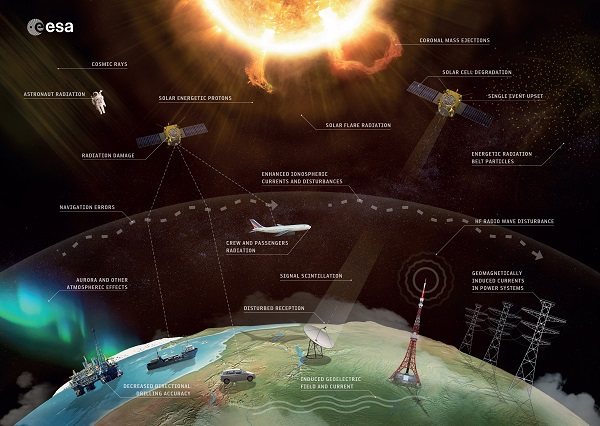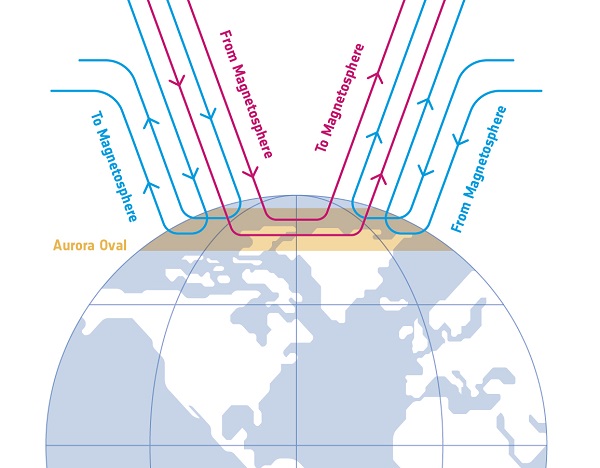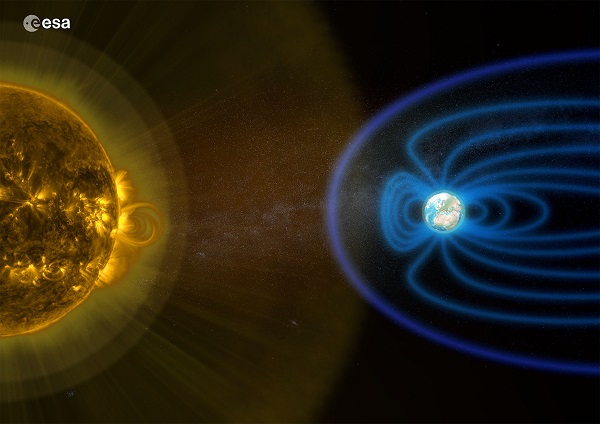- Learn & Discover
- Swarm data help estimate the i...
Swarm data help estimate the impact of space weather
20 Oct 2022
Energy from space weather mostly deposits itself as heat in the upper atmosphere, posing risks to satellites orbiting in the same altitude.
Recent research drawing on nearly seven years of high-resolution Swarm data, shows that the average space weather input is often underestimated.

Our unpredictable Sun blasts intense radiation and massive amounts of high energy material in all directions, to create constantly changing space weather.
These dynamic changes in the environment - caused by this solar wind - can influence the functioning of satellites, degrading communications and performance over their lifetime.
This degradation must be considered when designing satellites, so accurate estimations of space weather impacts are essential.
A research team, led by the Institute of Space and Atmospheric Studies at the University of Saskatchewan, in Canada, have drawn on data from ESA’s Swarm mission to help accurately estimate the influence of space weather [1].
The impact of space weather changes on Earth’s atmosphere is quantified by the Poynting flux - defined as the energy transfer rate between the magnetosphere and the ionosphere-thermosphere, via field aligned currents.
Lead researcher, Dan Billett from the University of Saskatchewan, explains, “The Poynting flux is how we quantify space weather energy - it is the measure of the energy that is transferred between the magnetosphere and the atmosphere because of interaction with the solar wind.

It’s important to quantify Poynting flux accurately, as quite a lot of that energy is released as heat – which then heats the atmosphere and increases its density. These density perturbations of the upper atmosphere can be catastrophic for satellites orbiting at high altitudes.”
The solar “destruction event” of almost forty Starlink satellites in February 2022, was caused by too much Poynting flux.
A day after the satellites launched, a solar storm heated the atmosphere to raise its density slightly, so that many of the satellites couldn’t maintain their altitude and de-orbited.
At small spatial scales - in the order of kilometres - conditions change very quickly and it’s difficult to measure Poynting flux due to the resolution of most instruments.
However, ESA’s Swarm constellation of satellites is equipped with electric field instruments that can retrieve measurements with a frequency of 16 Hz.
Billett says, “By using the recent release of Swarm 16 Hz re-processed data, we could access measurements once every 1/16 seconds - which equates to a spatial scale of one kilometre. We saw at those very small spatial scales, there’s more Poynting flux than is seen at larger spatial scales.”
Using ground-breaking space technologies, ESA’s Earth Explorer family of research missions have long contributed to monitoring Earth’s system.

The agency’s three-satellite Swarm mission is an operational Earth Explorer tasked with mapping Earth’s magnetic field as well as studying core dynamics, space weather and radiation hazards.
The researchers used approximately seven years of the newly reprocessed 16 Hz Swarm ion velocity data set, along with magnetic field measurements from the mission’s onboard magnetometers.
They investigated the effect of artificially smoothing out the data to simulate larger spatial scales and found that Poynting flux is underestimated by as much as fifty percent compared to spatial scales of 1000 km, which is close to the resolution of some ground-based instruments.
The Swarm constellation consists of three identical satellites named Alpha, Bravo, and Charlie (A, B and C). The research derived its calculation of Poynting flux using a combination of ion velocity and magnetic field measurements from Swarm A and B.
Not only do these research findings show that previous estimates of space weather energy were too low, but they also reveal that small-scale Poynting flux seem to contribute greatly to increases in density in the upper atmosphere, which can cause satellites to de-orbit.
This research was supported by the European Space Agency Living Planet Fellowship programme and by the National Sciences and Engineering Research Council of Canada (NSERC).
Find out more about Swarm data.
References
[1] D.D. Billett et al. “High-Resolution Poynting Flux Statistics from the Swarm Mission: How Much Is Being Underestimated at Larger Scales?” JGR Space Physics Volume 127, Issue 7 (2022)